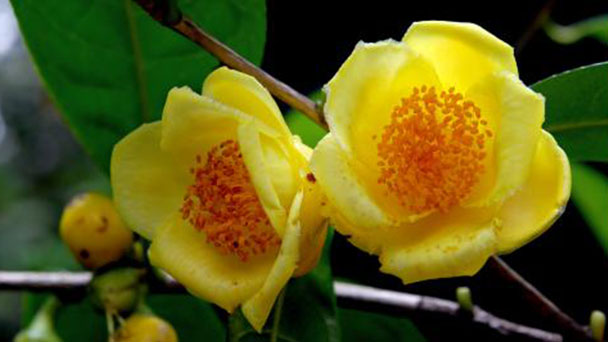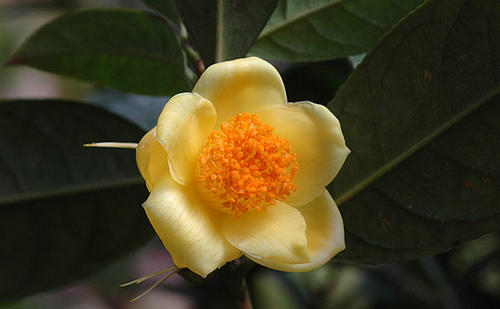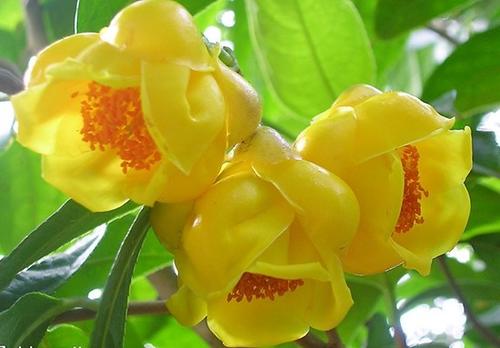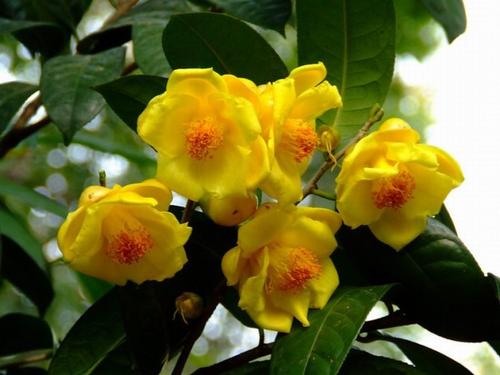Camellia chrysantha profile
Written by Maggie
Nov 01 2021

Camellia Chrysantha, known as the golden camellia, is a traditional Chinese specialty flower, is also the world's precious ornamental plant, and is a national protection of rare flowers and trees. Camellia Chrysantha is distributed in Guangxi and other places, generally growing in non - calcareous soil mountain evergreen forest. In addition to its high ornamental value, it can also be used to treat diseases.
Camellia Chrysantha (golden camellia) belongs to Camellia, Camellia chrysantha, and is a twin sister of tea, Camellia, Nanshan tea, Camellia, and Camellia chrysantha, etc. The brilliant yellow of Camellia Chrysantha, besmeared with wax, is translucent and glassy. camellia chrysantha occurs in the axils of leaves alone, and can be cup, pot or bowl in bloom. Before, people did not see the golden color of the species. Camellia Chrysantha, a golden yellow Camellia plant, was first discovered by Chinese scientists in 1960 in Nanning, Guangxi zhuang Autonomous Region. It is known as the Oriental magic tea abroad, known as the "giant panda of the plant world", "tea queen".
Camellia Chrysantha Picture

Growth Habit of Camellia Chrysantha
Warm and moist climate is favoured by Camellia Chrysantha (golden camellia), which can be found in shady valleys with loose soil and good drainage. Chrysantha can often live with plants such as Camevine, chrysantha, acacia, Nanmu, and limper. Due to its extremely narrow natural range, Camellia Chrysantha can only be found in limited numbers in the low hills of Sixian, 100 to 200 meters above the 100,000 mountains of Guangxi province. Chinese scientists are collaborating on crossbreeding experiments to produce better varieties of the national treasure. In recent years, China kunming, Hangzhou, Shanghai and other places have been introduced and cultivated.
Appearance of Camellia Chrysantha
Camellia Chrysantha (golden camellia) is an evergreen shrubs or small trees, 2-- 6m tall, with pale, smooth bark.Leaves alternate, broadly lanceolate to oblong. Flowers are single leaf axils or near terminal, flowers golden yellow, cup, pot or bowl shaped when open, 3-3.125 px in diameter; Camellia Chrysantha has 9-11 petals, broadly ovate to obovate or rounded, fleshy, waxy; Flowering period is from November to March of the following year. The capsule is triangular-oblate, yellowish-green or purplish-brown; Fruit period: October-December.

Propagation and cultivation of Camellia Chrysantha
Sowing, graft and propagation of Camellia Chrysantha (golden camellia). Cultivation of soil should be breathable, not water. Shady trees should be installed during the seedling stage, potted plants should be used in the north of the Yangtze River basin, and greenhouses should be moved in winter. Warm-blooded plants of Camellia chrysantha are tropical and possess high thermal requirements, but their performances are different from each other and from different reproductive stages. Introduced to the subtropical climate can be normal growth and development. Moist and wet characteristics of Camellia Chrysantha, different seasons and different growth stages have different water and wet conditions, higher requirements for vegetative growth stage, and too much rain in flowering stage can easily cause falling flowers. Camellia Chrysantha can not tolerate direct sunlight, and is a shade tolerant plant. The illuminance required is generally 320-600LAX, but there are some interspecific differences. Under different lighting conditions, plant growth, firmness, regeneration ability are positively correlated with shade. Plants of Camellia chrysantha can be divided into two categories: acid-tolerant and calcium-tolerant Camellia chrysantha, which can be found in two different types of soil under natural conditions. However, under artificial introduction and cultivation, some types of Camellia chrysantha can grow on acid soil. Ash content and element requirements of two types of Camellia chrysantha growing in different soils are different.
Application of Camellia Chrysantha
Golden yellow colors of Camellia chrysantha (golden camellia), with wax-like luster and crystal and lovely, can be found in various forms, including cup, pot, bowl and dish. They are beautiful and graceful in various forms, and are known as the "Empress of the Tea clan" among Camellia groups. In subtropical areas, evergreen broad-leaved trees can be planted or shaded for viewing.

Latest Updated
- Benefits of Bugleweed - 7 Science-backed Health Benefits
- Bugleweed Dangers & Side Effects - Is It Poisonous?
- How to Plant Evergreen Trees - What You Should Know
- When to Plant Evergreens - Grow Guide for Evergreen Trees
- 12 Wonderful Evergreen Shrubs for Your Garden
- 12 Popular Evergreen Plants with Pictures for Beginners
- When And How To Prune A Lilac Bush Like a Pro
- How to Grow & Care for Lilac Vine (Hardenbergia Violacea)
- Japanese Lilac Tree (Syringa Reticulata) Care & Propagation Guide
- Shumard Oak Pros and Cons - What to Know
Popular Articles
- Winter maintenance of Antirrhinum Majus
- How to Grow Terminalia Mantaly Tree
- How to Grow and Care for Crossostephium Chinense
- How to grow Antirrhinum Majus in spring
- Peristeria Elata (Dove Orchid) Profile: Info & Care Guide
- Underwatered Snake Plant (Sansevieria Trifasciata) - Signs And How To Fix
- How to Care for Brazilian Jasmine Plant (Mandevilla Sanderi)
- How to Grow & Care for Graptopetalum Purple Delight in Summer
- Rosa Chinensis (China Rose): Plant Growing & Care Tips
- How to Care for Baby Sun Rose (Aptenia Cordifolia)